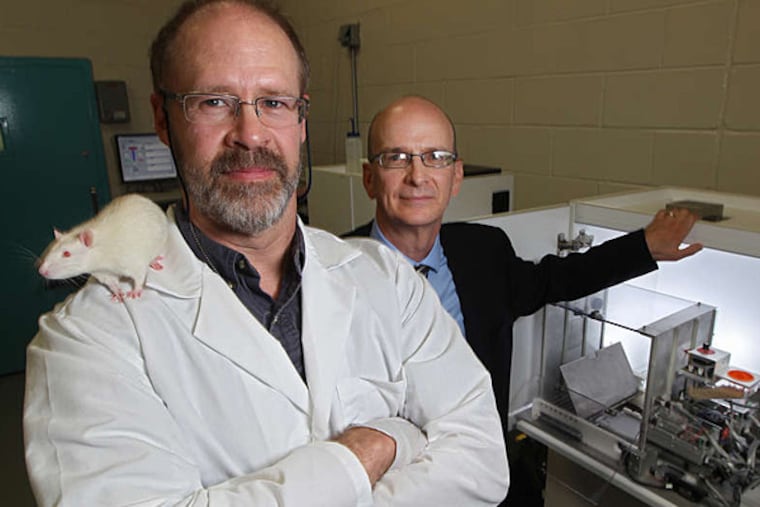Entrepreneurs use rats to find tasty ingredients
Let us now consider the unwanted guest at the overflowing table of modern society. Perhaps we see the pointy teeth, the beady eyes, the long tail, and we think, "Yuck!"

Let us now consider the unwanted guest at the overflowing table of modern society.
Perhaps we see the pointy teeth, the beady eyes, the long tail, and we think, "Yuck!"
Scott Horvitz and R. Kyle Palmer see all those things and think, "Business opportunity!"
We speak of the rat, and of its appetite for human leftovers. Why not put that tendency to good use?
Horvitz and Palmer are the brains behind Opertech Bio Inc., a new Philadelphia-based start-up company that is using rats to test potential flavor additives for human food, and they seem to be on to something.
This month, Palmer reported in an academic journal that the animals were able to identify sweet, salty, bitter, and other flavors with high accuracy, evaluating 96 compounds in little more than an hour.
What's more, on behalf of an Opertech client, the animals have identified a new no-calorie sweetener that already has been validated in human taste tests, Horvitz said.
Alexander A. Bachmanov, a behavioral geneticist who works with rats at the Monell Chemical Senses Center in Philadelphia, is impressed with the company's results, published in the journal PLoS ONE.
"I think the rats are amazing performers," said Bachmanov, who was not involved with the research.
In the eternal search for yummy new artificial and natural flavors, the food and beverage industry long has relied on humans to put candidate ingredients to the test. But human taste tests are time-consuming and expensive.
So in the last decade, flavor companies have tried to speed up the process with so-called cell-based assays: laboratory tests that can help winnow down a list of thousands of possibilities, somewhat like what is used in the pharmaceutical industry to find drugs. These tests reveal whether, say, a particular compound will bind to a sweet "receptor" like the one in the human tongue.
That is still not enough to know whether the compound tastes good, said Palmer, a pharmacologist by training, who is Opertech's chief science officer.
And so, in a small lab in North Philadelphia, furry animals are at work in small metal and fiberglass cages. They are Sprague-Dawley rats, a standard laboratory strain with white fur.
Each animal is trained in advance to identify a taste such as sweet or salty, and then is presented with 96 candidate compounds, one at a time, through a small hole in the cage floor.
If it licks the sample 30 or 40 times, it means it likes it, Palmer said. Just one or two times? A sign of rat displeasure.
Whether it likes the compound or not, the animal is trained to then press a certain lever if the flavor corresponds to the taste it has been trained to recognize. Some press the lever with a paw, others with their teeth or snout.
"They all have their own style," said Horvitz, the company's chief executive officer. "Like a baseball player has a different batting stance."
A rat that successfully identifies a flavor is rewarded with a food pellet.
The rat-testing machine was invented by Palmer when he and Horvitz were at another company, Redpoint Bio, which is now winding down its operations. They left to found Opertech 18 months ago, and acquired the taste-testing technology from Redpoint. The company has one other full-time employee, plus periodic interns.
Horvitz declined to disclose its revenue, but he has done well in the past. A longtime biotech executive, he cofounded 3-Dimensional Pharmaceuticals Inc., which was bought by Johnson & Johnson in 2003.
Flavor-industry consultant Herbert Stone, a longtime sensory scientist and past president of the Chicago-based Institute of Food Technologists, said Opertech's rats would be a great time-saver.
What's more, their efforts will spare human subjects from having to taste some of the less-desirable flavor candidates.
"Many of these materials, even at very low levels," Stone said, "are very bitter."
Identifying a compound is just one step. Food manufacturers also must gauge the cost of mass-producing an ingredient, plus evaluate its safety - both of which must be done for the no-calorie sweetener that the rats identified.
Still, Horvitz and Palmer are optimistic that their efforts will land on store shelves.
But why rats? To start with, the animals are omnivores just like people, said Bachmanov, the scientist from Monell - a well-known landmark in West Philadelphia, thanks to its big statue of a nose on the Market Street sidewalk.
And ever since rats engaged in, ahem, cohabitation with humans, the ones that learned to fancy human food were at an advantage.
Throw in the fact that the furry beasts, though much maligned, are pretty sharp. They have learned to live in a variety of nonnative environments, such as sewers and subways.
Said Bachmanov: "It's one of the most successful species on our planet."
Yum.